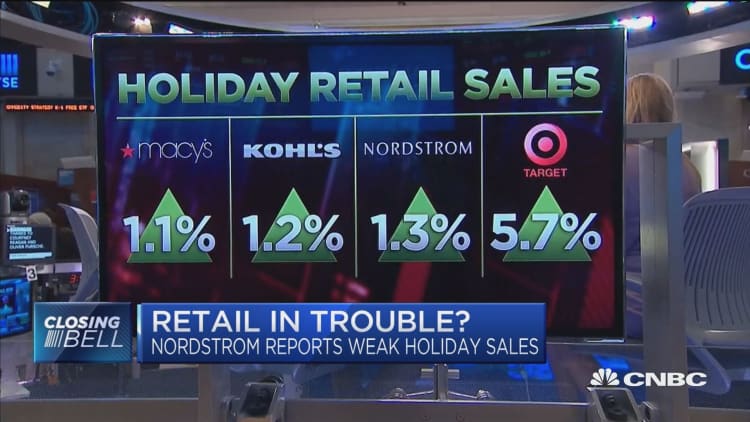Department store chains aren't giving the retail industry much to cheer about coming out of the holiday season. Instead, it's been a lot of doom and gloom to kick off 2019.
Macy's, J.C. Penney, Nordstrom and Kohl's each have given Wall Street a glimpse of holiday sales. And even Nordstrom, often declared a top performer in the space, struggled to draw shoppers to its full-price stores during November and December.
Some called out a longer-than-anticipated drop-off in traffic between Black Friday and Christmas. And some said they've now been left with more inventory than normal and will have to use steeper promotions to get rid of merchandise. That means even more pressure on profits.
The fear now is that if these companies weren't able to perform when the consumer environment was arguably the strongest it's been in a while in the U.S., 2019 could be even worse. An ongoing partial federal government shutdown (the longest in history), cooling global growth and a trade war with China are just a few things that could begin to impact how much shoppers are willing to spend.

"When you hear three weeks ago that this was the best consumer environment ever, you go: 'Wait a minute. What changed overnight?'" said Stacey Widlitz, president of SW Retail Advisors.
Macy's in particular — with more than 690 stores across the U.S., including Bloomingdale's — has served as a sort of barometer for its peers. When the company said it didn't sell as much women's sportswear, sleepwear, fashion jewelry and cosmetics during the holidays as executives had hoped, Macy's shares had their worst day ever, cratering nearly 18 percent. It brought many retail stocks down with it too.
Macy's stock is now down 6 percent over the past 12 months, a much more modest decline than J.C. Penney, which has tumbled more than 65 percent over the same period, to hover right around $1.30. Nordstrom shares are down about 11 percent over that time period, while regional department store chain Dillard's stock is down 8 percent over the past year.
Speaking at the National Retail Federation's Big Show in New York this past week, Macy's CEO Jeff Gennette made no mention of the retailer's dismal performance this past holiday season. Instead, his panel session was focused on Macy's bringing new tech and pop-up marketplaces to its stores. But some analysts have said these efforts aren't really moving the needle.
"Now, as we are positioned in 2019, if Macy's is leading with the downside, when is the shoe going to drop at Target, as good as they are?" Widlitz said. "Are they next?"
Target's holiday sales were more upbeat than most, and the company says it's still on track to make 2018 its best year for same-store sales growth since 2005. Unlike most of the department store operators, Target has found success in launching in-house brands for apparel and home goods that amass somewhat cultlike followings. And though its food business isn't on par with Walmart's, it still serves as a traffic driver to Target stores.
A company like J.C. Penney, on the other hand, is struggling to give shoppers a reason to go there when they could shop directly from a brand like Nike's website. Its stores are outdated, unsold inventory is piling up and merchandising isn't resonating with millennials, a key demographic that should be on all retailers' radars. Some analysts are wondering if it could be the next major retailer to head down the same path of now bankrupt Bon-Ton and Sears. J.C. Penney's stock hit a low of 92 cents on Dec. 27.
"The 2018 liquidation of Bon-Ton offers a salutary lesson regarding the market's growing impatience with troubled companies that have underinvested and executed well below better capitalized peers," Moody's analyst Christina Boni said. "The market's growing impatience will be putting a brighter spotlight on struggling companies like J.C. Penney during 2019. ... J.C. Penney has been a significant laggard."
More store closures
Department store chains altogether trimmed their square footage by 13 percent in 2018, according to Moody's. And the firm expects that category to shrink further this year.
With the fate of Sears' hundreds of remaining stores still uncertain, J.C. Penney has already said it's evaluating its real estate and will provide more details about additional store closures when it reports earnings next month. It's already planning to close three locations in 2019.

Meanwhile, Macy's and Kohl's continue to experiment with ways to make use of excess space in stores, realizing having upward of 100,000 square feet of selling space per location doesn't make sense. That's where Macy's has opened up pop-up marketplaces and hinted at bringing in other retailers or creating mini fulfillment centers in some shops. And Kohl's is in the process of dividing up some of its massive stores for tenants like Aldi to move in next door.
Kohl's shares have been faring better than its department store peers. The stock is up about 6 percent from a year ago. The company has benefited from the fact that its stores are normally free-standing and aren't attached to malls, where foot traffic has been declining.
More store closures are inevitable as department store chains are forecast to continue to lose market share. Morgan Stanley predicts department stores will only comprise about 8 percent of the total U.S. apparel market in 2022, compared with 24 percent in 2006.
"Brands are plugging the department store 'leaky bucket' hole with growth on Amazon.com," Morgan Stanley analyst Brian Nowak said.
In 2019, department store chains will need to prove they still have a reason to exist, first and foremost.
Inventories will need to get back to healthy levels without sacrificing too much profit. Investments need to be made in websites and mobile apps because that's where more shoppers are buying things today. They also need to invest in store remodels to keep up with the new stores — from the likes of online brands including Untuckit, Warby Parker and Away — that are just opening. And they need to generate excitement — to make the experience in a Macy's or Nordstrom store an enjoyable one.
"Department stores have to define who they want to be in this new era," Ryan Fisher, a partner at consulting firm A.T. Kearney, said. "To me, the pressure is on them."


